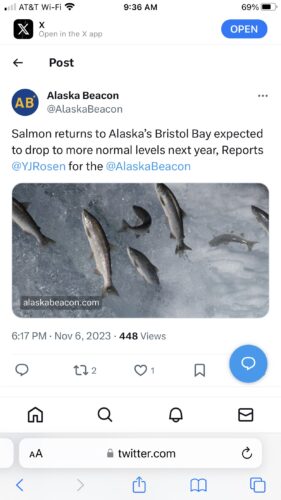
Bristol Bay Sockeye Forecast Looking Smaller Than Recent Years, But Still Strong

After record-setting runs of salmon in recent years, Bristol Bay’s 2024 sockeye forecast appears to be more normal, though it’s still perceived as a health amount of fish.
Here’s more from the Alaska Beacon:
The 2024 Bristol Bay sockeye salmon run is expected to total 39 million fish, with a predicted range between about 25 million and 53 million fish, according to a preliminary forecast released Friday by the Alaska Department of Fish and Game.
That is 35% lower than the average over the past 10 years but 6% higher than the long-term average for Bristol Bay, the department said in its forecast.
Bristol Bay is site of the world’s largest sockeye salmon runs, and recent years’ returns have been especially large. Last year’s sockeye salmon return hit a record of 79 million fish, and the 2022 harvest of 60.1 million sockeye salmon was also a record, according to the department. This year’s run totaled 54.5 million, the eighth largest on record, according to the department.
If the run comes in as forecasted, it would be about the same size as runs in the early 2000s, according to state records.
Here’s a link to last week’s ADFG report, which includes the following information:
RESULTS
A total of 39.00 million sockeye salmon (with a range of 24.89 to 53.12 million) are expected to return to Bristol Bay in 2024 (Table 2). This is 35% smaller than the most recent 10-year average of 60.20 million fish and 6% greater than the long-term average of 36.83 million fish (1963–2023). All systems are expected to meet their spawning escapement goals in 2024. The forecast range is the upper and lower values of the 80% confidence interval for the total run forecast. The confidence bounds were calculated from the difference between actual runs and run forecasts from 2005 through 2023.
A run of 39.00 million sockeye salmon would allow for a potential harvestable surplus of 26.11 million fish; 25.01 million fish in Bristol Bay and 1.10 million fish in the South Peninsula June fishery. A Bristol Bay inshore harvest of this size is 39% less than the most recent 10-year average harvest of 40.72 million (ranging from 28.75 to 60.52 million), and 8% greater than the long-term average harvest of 23.15 million fish (1963–2023).
Age-specific forecasts for the 2024 run consist of 19.61 million age-1.2 fish (50% of the total run), 5.17 million age-2.2 fish (13% of the total run), 12.06 million age-1.3 fish (31% of the total run), and 2.07 million age-2.3 fish (5% of the total run; Table 2).
DISCUSSION
Forecasting future salmon returns is inherently difficult and uncertain. The department has used similar methods since 2001 to produce Bristol Bay sockeye salmon forecasts, which have performed well when applied to Bristol Bay as a whole. Since 2001, our forecasts have, on average, under-forecast the run by 15% and have ranged from 36% below the actual run in 2014 to 21% above the actual run in 2011. Forecasted harvestable surplus has had a mean absolute percent error of 15% since 2001.
Individual river forecasts have greater uncertainty compared to the baywide forecast. Since 2001, we have on average, under forecast returns to the Alagnak (-31%), Togiak (-10%), Kvichak (- 22%), Wood (-20%), Nushagak (-24%), Ugashik (-3%), and Naknek (-12%) rivers, and over forecast returns to the Igushik (7%) and Egegik rivers (8%). Over forecasting returns to some rivers while under forecasting returns to other rivers means that the overall Bristol Bay forecast is often more accurate than the forecast to any individual river.



